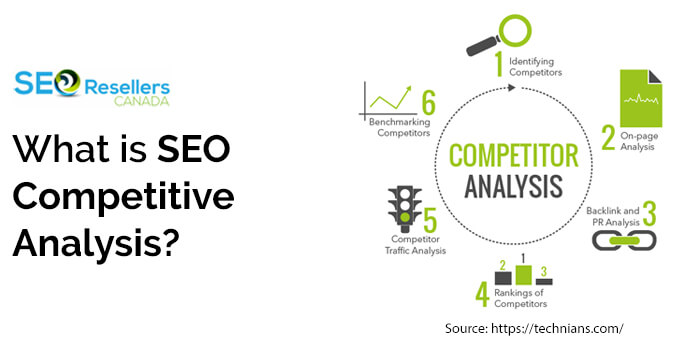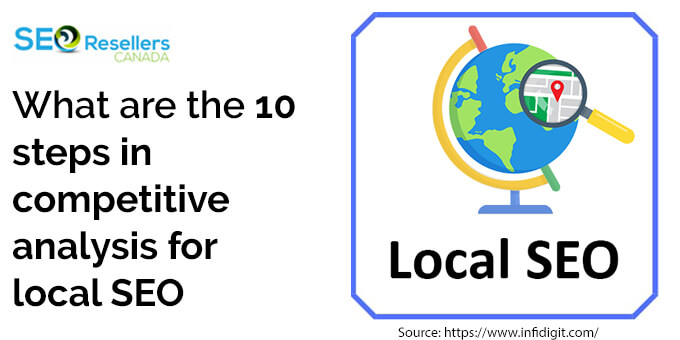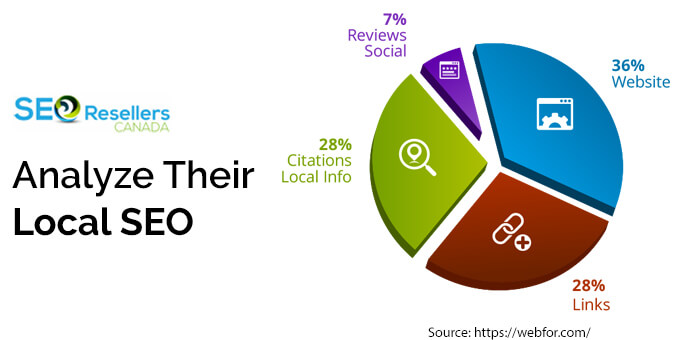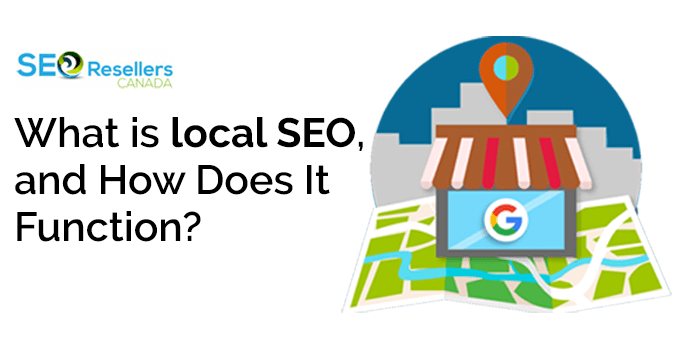As a local business owner, you want to ensure that your business is seen by the right local customers, which is why a competitive analysis for local SEO should be a priority.
Competitive analysis for local SEO is a process of researching and comparing your local competitors’ organic search engine optimization (SEO) efforts. It helps you to identify their strengths and weaknesses so that you can improve your own SEO and make sure that your local business is gaining an edge over the competition.
In this blog, we’ll discuss the importance of performing a competitive analysis for local White label SEO, and provide step-by-step instructions on how to do one. We’ll also provide helpful tips and resources to make sure that you can get the most out of the process. With this information, you’ll be able to make sure that your local business has the best chances of success by optimizing your SEO and staying ahead of the competition.
1- What is SEO Competitive Analysis?

SEO competitive analysis is the process of researching and examining the digital marketing strategies of competitors in order to gain a better understanding of the search engine optimization (SEO) landscape.
It is an essential part of White label SEO that should be performed regularly in order to identify potential opportunities to gain an edge over competitors. Through SEO analysis, companies can assess the strengths and weaknesses of their competitors and uncover potential areas where they have a competitive advantage.
2- What are the key factors in SEO competitive analysis?
When performing an SEO analysis, it is important to consider the following factors:
2.1- Keyword Research

When conducting a competitive analysis report, it is important to identify the relevant competitor keyword analysis. This can be done by using keyword research tools such as Google Keyword Planner or SEMrush. By assessing the keywords that competitors are targeting, companies can identify potential areas to focus their own SEO efforts on.
2.2- Backlink Analysis
Backlink analysis is another important aspect of SEO competitive analysis. By examining the backlinks of competitors, companies can gain insight into the strategies they are using to build authority and increase their rankings in the search engine results pages (SERPs).
2.3- Content Analysis

Content analysis involves examining the content that competitors are creating, such as blog posts and webpages. Companies can use this information to identify potential topics to focus their own content creation efforts on.
2.4- Ranking Analysis
Ranking analysis involves assessing the rankings of competitors in the SERPs. Companies can use this information to identify potential areas to focus their own SEO efforts on in order to gain an edge over competitors.
By performing an SEO competitor analysis on a regular basis, companies can gain a better understanding of the current SEO landscape and identify potential areas to focus their own efforts on. This can help them gain an edge over their SEO competitors analysis and improve their rankings in the SERPs.
3- Why should we look at local SEO competition?

Competition is a key element that must be considered when it comes to SEO. Being aware of what your rivals are doing will help you keep one step ahead of them and increase the visibility of your website in search engine results pages (SERPs).
For companies with a physical location, local SEO competition is particularly crucial because it’s likely that other companies in the neighborhood are focusing on the same keywords. Businesses can learn how their rivals are positioning themselves in the local search landscape by examining the local Kelowna SEO competition. By making changes to their own strategies, they can stay one step ahead of the opposition.
There are a number of things to take into account while analyzing local SEO competition. First, think about the kind of material your rivals are producing. Do they offer informative blog pieces or how-to guides? If so, you may produce content that targets the same keywords in a similar way. You should take into account the quality of those connections in addition to the quantity of backlinks they have. You may learn more about the kinds of content and tactics they employ to establish authority in the local search market by doing this.
The keywords that they are focusing on should also be taken into account when analyzing local SEO competition. You may acquire insight into the kinds of inquiries that are likely to drive traffic and direct your efforts accordingly by analyzing the keywords your rivals are using. You may also examine the different SERPs they are showing up in and modify your own techniques accordingly.
Finally, you should take into account how well your rivals are represented on social media. Look at the platforms they use, the content they share, and how frequently they interact with their audience. If your rivals are active on social media, you should concentrate on developing and using your own social media platforms.
Businesses can learn a lot about the techniques and strategies that their rivals are employing to stand out in the local search landscape by examining the local SEO competition. They can use this information to decide on their own SEO strategies and stay one step ahead of the competition.
4- What are some tools to help with local SEO competition analysis?

When it comes to local SEO, analyzing the competition can be a daunting task. Fortunately, Google provides several tools to help businesses identify and analyze their competition. By taking advantage of these tools, businesses can gain valuable insight into the competition and identify opportunities for improvement.
4.1- Google Search Console
The first tool businesses should take advantage of is the Google Search Console. This tool provides detailed information about how your website is performing in search results and which queries are driving the most traffic. By comparing this data to other websites in the same niche, businesses can identify opportunities for improvement.
4.2- Google AdWords
Another useful tool for analyzing local SEO competition is Google AdWords. This tool allows businesses to view the bids and performance of their competitors’ ads in real-time. By looking at the performance of your competitors’ ads, businesses can identify which keywords are driving the most traffic and adjust their own campaigns accordingly.
4.3- Google My Business
Google My Business is a must-have for any business looking to optimize its local SEO. This tool allows businesses to manage their presence on Google’s search results page and view their competitors’ listings. By analyzing the listings of other businesses in the same niche, businesses can identify opportunities for improvement and gain valuable insights into their competition’s strategies.
4.4- Google Trends
Google Trends is a great tool for understanding the overall interest in a business’s products and services. By monitoring trends related to the business’s niche, businesses can identify opportunities for improvement and better understand the competition.
Analyzing local SEO competition is an essential part of any local SEO strategy. By taking advantage of the tools provided by Google, businesses can gain valuable insight into the competition and identify areas for improvement. With the right strategy, businesses can stay ahead of their competition and maximize their local SEO potential.
5- What are the 10 steps in competitive analysis for local SEO

5.1- Identify Your Competitors
The first step in any analysis is to find out who your competitors are. There are a few different ways to do this. You can use search engine results pages (SERPs) to see who’s ranking for the same keywords you’re targeting or use a tool like Google Analytics to view your website’s organic traffic and see where it’s coming from. You can also ask local businesses in your industry about whom they view as their main competitors.
5.2- Analyze their Local SEO

Once you’ve identified your competitors, the next step is to analyze their local SEO. Start by looking at their website and seeing how optimized it is for local search.
Check to see if they have a local business listing on Google My Business and other local directories and if they’re optimizing their content for local keywords. Also, look at their backlink profile to see if they’re doing any link building to boost their local SEO marketing.
5.3- Analyze Their Content Strategy
Next, take a look at your competitors’ content strategy.
- What kind of content are they producing?
- Are they producing content that’s specifically targeted to local audiences?
- Are they optimizing their content for local keywords?
- Are they posting on their blog regularly?
- Are they creating content that’s engaging and shareable?
All of these things can give you insights into how your competitors are approaching their content marketing.
5.4- Analyze Their Social Media Strategy

Social media is an important part of local SEO, so it’s important to analyze your competitors’ social media strategy. Start by looking at which social networks they’re active on, and how often they’re posting.
Also, look at the type of content they’re sharing and how engaging it is. Are they using any social media ads? Do they have any followers or engagement on their posts?
These answers give a peek into how your competitors are using social media and what kind of results they’re getting.
5.5- Identify Your Competitors
Local reviews are a major factor in local SEO, so it’s important to analyze your competitors’ reviews. Start by looking at the number of reviews they have and the average rating they’re getting.
You can also check their reviews for patterns and patterns in the feedback they’re getting by looking at their content. This can give you insights into how your competitors are engaging with their customers and what kind of results they’re getting.
5.6- Analyze Their Link Building Strategy

Link building is an important part of SEO, and it’s especially important for local SEO. Take a look at how your competitors are building links.
- Are they doing guest blogging?
- Are they getting listed in local directories?
- Are they participating in link-building campaigns?
- Are they getting links from other local businesses?
Analyzing your competitors’ link-building strategy can give you insights into their SEO strategy and help you develop your own link-building plan.
5.7- Analyze Their Paid Advertising
Paid advertising can be a powerful tool for local SEO Canada, so it’s important to analyze your competitors’ paid advertising strategy.
- Start by looking at which platforms they’re using and what type of ads they’re running.
- Are they running display ads, search ads, or both?
- Are they using any retargeting?
- Also, assess their budget and the results they’re getting.
Doing so can offer you insights into how your competitors are using paid advertising and what kind of results they’re getting.
5.8- Analyze Their Mobile Presence

With more and more people using mobile devices to search for local businesses, it’s important to analyze your competitors’ mobile presence. Start by looking at their website and seeing how optimized it is for mobile in terms of outreach and engagement.
- Are they using a mobile-friendly theme?
- Are they optimizing their content for mobile search?
- Do they have a mobile app?
- Are they active on social networks like Instagram and Snapchat?
5.9- Analyze Their Local Events Strategy
Local events can be a great way to generate interest in your business and get your name out there in the local community. Take a look at how your competitors are using local events to promote their business.
- Are they hosting their own events?
- Are they attending events hosted by other businesses in the area?
- Are they sponsoring local events?
Analyzing your competitors’ local events strategy can give you insights into how they’re engaging with their local customers.
5.10- Analyze Their Overall Strategy

Finally, take a look at your competitors’ overall strategy. Are they focusing on organic search, paid advertising, social media, or a combination of all three? Are they focusing on local search or a more global audience? Are they targeting a specific niche or a broader market?
Analyzing your competitors’ overall strategy can give you insights into their overall approach and help you develop your own local SEO strategy.
By following these ten steps, you can get a comprehensive picture of your competitors and how they’re approaching their local SEO. This will allow you to make informed decisions on where to focus your own efforts and how to best stand out in the local market.
6- Our parting thought
Understanding how to do a local SEO competitor analysis is a great way to ensure your business reaches its full potential.
It can help you understand what your competitors are doing and what you can do to set yourself apart. With the right data, you can create an SEO strategy that will get you to the top of the search engine results pages.
By taking the time to do a thorough analysis, you’ll understand the strengths and weaknesses of your competitors, identify opportunities to outrank them, and ultimately create an SEO strategy that will increase your visibility and drive more organic traffic to your website.
With the right tools and the right knowledge, you can create a comprehensive SEO strategy that will give you the edge you need to stay ahead of the competition.



















